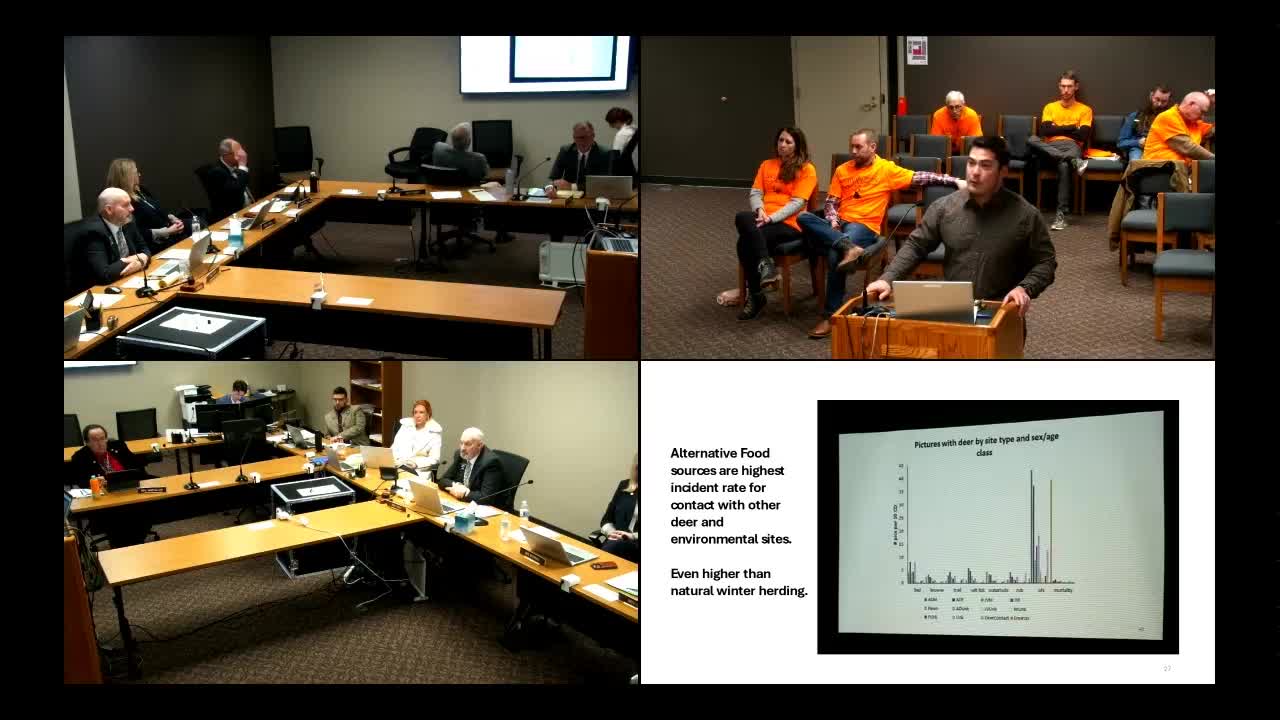Debate intensifies over deer baiting laws as disease prevalence rises across North America
January 17, 2025 | Agriculture and Veterans Affairs, Senate, Legislative, North Dakota
This article was created by AI summarizing key points discussed. AI makes mistakes, so for full details and context, please refer to the video of the full meeting. Please report any errors so we can fix them. Report an error »

The Senate Agriculture and Veterans Affairs meeting held on January 17, 2025, in North Dakota focused on the implications of deer baiting and feeding practices in relation to the spread of neurological diseases among deer populations. A significant portion of the discussion centered on the effectiveness of these practices and their correlation with disease prevalence in various states and provinces.
One key speaker highlighted the concern that baiting and feeding could exacerbate the spread of diseases, particularly by aggregating deer in specific locations. The speaker compared North Dakota's situation with that of Saskatchewan, where baiting is prevalent. They noted that Saskatchewan has experienced a much higher incidence of disease cases, with over four times as many reported cases compared to North Dakota, despite both regions having similar durations of disease presence. This comparison aimed to illustrate the potential risks associated with baiting practices.
The speaker also referenced other states, such as South Dakota and Colorado, which do not allow baiting and have maintained lower disease prevalence rates. In contrast, Kansas, which permits baiting, has seen a rapid increase in disease cases, indicating a troubling trend. The data presented suggested that states with strict baiting regulations, like Colorado, have managed to keep disease prevalence significantly lower than those that allow baiting.
The discussion underscored the ongoing debate about the balance between hunting practices and wildlife health management. The speaker emphasized the need for evidence-based approaches to address the concerns surrounding baiting and its impact on deer populations. They acknowledged the challenges faced by ranchers and hunters but advocated for continued efforts to mitigate the spread of disease through responsible wildlife management practices.
In conclusion, the meeting highlighted the critical need for further examination of baiting regulations and their implications for wildlife health in North Dakota and beyond. The discussions are expected to inform future policy decisions aimed at protecting deer populations while considering the interests of hunters and ranchers.
One key speaker highlighted the concern that baiting and feeding could exacerbate the spread of diseases, particularly by aggregating deer in specific locations. The speaker compared North Dakota's situation with that of Saskatchewan, where baiting is prevalent. They noted that Saskatchewan has experienced a much higher incidence of disease cases, with over four times as many reported cases compared to North Dakota, despite both regions having similar durations of disease presence. This comparison aimed to illustrate the potential risks associated with baiting practices.
The speaker also referenced other states, such as South Dakota and Colorado, which do not allow baiting and have maintained lower disease prevalence rates. In contrast, Kansas, which permits baiting, has seen a rapid increase in disease cases, indicating a troubling trend. The data presented suggested that states with strict baiting regulations, like Colorado, have managed to keep disease prevalence significantly lower than those that allow baiting.
The discussion underscored the ongoing debate about the balance between hunting practices and wildlife health management. The speaker emphasized the need for evidence-based approaches to address the concerns surrounding baiting and its impact on deer populations. They acknowledged the challenges faced by ranchers and hunters but advocated for continued efforts to mitigate the spread of disease through responsible wildlife management practices.
In conclusion, the meeting highlighted the critical need for further examination of baiting regulations and their implications for wildlife health in North Dakota and beyond. The discussions are expected to inform future policy decisions aimed at protecting deer populations while considering the interests of hunters and ranchers.
View full meeting
This article is based on a recent meeting—watch the full video and explore the complete transcript for deeper insights into the discussion.
View full meeting
